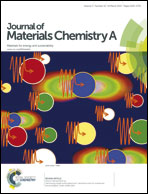Electrical properties and flux performance of composite ceramic hydrogen separation membranes†
Abstract
The electrical properties and hydrogen permeation flux behavior of the all-ceramic protonic/electronic conductor composite BaCe0.2Zr0.7Y0.1O3−δ/Sr0.95Ti0.9Nb0.1O3−δ (BCZY27/STN95: BS27) are evaluated. Conductivity and hydrogen permeability are examined as a function of phase volume ratios. Total conductivities of 0.01–0.06 S cm−1 are obtained in moist (+1% H2O) H2/inert gas from 600–800 °C for 50 volume% STN95. With increasing STN95 content (60 and 70 volume%), conductivity increases by 5–10 times, but displays a semiconductor-type dependence, even at 70 volume% STN95. The conductivity is modeled with an effective medium approach incorporating a term for the heterojunctions between the two phases. Hydrogen fluxes of 0.004–0.008 μmol cm−2 s−1 are obtained for a 50 volume% STN95 membrane sample (1 mm thickness) at 600–800 °C using dry argon as a sweep gas. Upon adding palladium layers as catalysts more than a five-fold increase is observed in the hydrogen flux, 0.025–0.026 μmol cm−2 s−1, over the same temperature range. Hydrogen flux is not observed for membranes made from the 60 and 70% STN95 samples.


 Please wait while we load your content...
Please wait while we load your content...